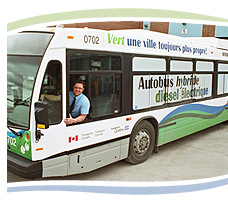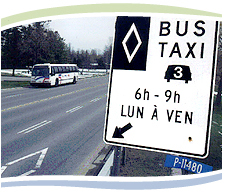
© STO
The Ligne verte (green bus route) of the Société de transport de l'Outaouais (STO) is part of Transport Canada's Urban Transportation Showcase Program (UTSP). The program provides support for projects being undertaken by different organizations in Canada with the aim of discovering sustainable transportation options in order to reduce greenhouse gas (GHG) emissions into the environment. Many specific aspects of these multi-year projects must be constantly evaluated and measured to determine the environmental impact and cost effectiveness of the projects.
Subsidized by the Canadian government, the UTSP made it possible to reach the following objectives:
- Support the development and integration of strategies, transportation planning tools and best practices so as to reduce GHG emissions;
- Demonstrate, measure and monitor the effectiveness of a range of integrated urban GHG strategies;
- Evaluate the effects of these strategies for other important policy objectives to build strong cities (smog reduction, congestion relief, improved public transit infrastructure); and,
- Establish a comprehensive and pro-active national network for the dissemination of information on successful GHG reduction strategies for sustainable urban transportation.
![]()

![]()
The public transit demonstration project that's been undertaken by the STO, in partnership with the Société de transport de Montréal (STM), is part of the City of Gatineau's development strategy and was intended to foster better use of this mode of transportation by increasing the modal share and using technologies that have low greenhouse gas emission levels.
The STO'S PROJECT consisted in evaluating the effect that a combination of measures, including the use of two hybrid diesel-electric buses and the introduction of various measures to improve service in a given corridor, would have on the amount of greenhouse gases emitted.
The performance of the hybrids has been compared with the performance of seven diesel buses for a period of almost two years, or until March 2009. These evaluations were carried out within a clearly defined corridor composed of the axis formed by Gréber, Fournier and Maisonneuve boulevards to the Portage Bridge. As part of the project, this corridor was called the Ligne verte (green route). These buses ran primarily along routes 65, 67 and 77 during the morning and afternoon peak hours, although it was possible to see them elsewhere in the city during evenings and weekends.

© STO
![]()
The two hybrid diesel-electric buses and seven regular diesel buses dedicated to the project that ran along Gréber, Fournier and Maisonneuve boulevards to Ottawa had an environmental look.
![]()

© Serge Paquin
With more than 10,000 daily trips along the Gréber, Fournier and Maisonneuve axis, this corridor is one of the most heavily used by commuters going to the downtown area of the Hull sector or Ottawa. Furthermore, it was possible to add preferential measures here such as reserved lanes, new incentive parking facilities and priority lights at intersections. It was also easier to isolate specific bus routes, in this case routes 65, 67 and 77, unlike other boulevards that are served by a multitude of bus routes.
Interactive Map
of the Ligne verte
![]()
Using two hybrid diesel-electric buses and introducing preferential measures made it possible to evaluate the following aspects:
Reduction in CO2 emissions: Using cleaner vehicles helps contribute to reducing the greenhouse gases released into the air. Comparing the data gathered on the seven diesel buses in the project with the data from the two hybrid vehicles made it possible to efficiently evaluate the environmental performance of the hybrid technology with respect to how many fewer tonnes of CO2 were released into the air. In addition, introducing priority measures encouraged the use of public transit, thereby also reducing the number of vehicles on the roads.
Reduction in fuel consumption: The two hybrid buses operate by combining electric power and diesel, thereby burning less fuel than a vehicle that runs only on diesel. The study allowed us to determine exactly how many litres were saved, which in turn told us the amount of GESs that were not released into the air.
Benefits for riders: The evaluation allowed us to find out what riders think of hybrid vehicles, especially with regard to riding comfort and noise. It also allowed us to ensure regular service through the introduction of priority measures for buses, such as adding reserved lanes and installing priority lights at intersections.
Maintenance cost: The study allowed us to compare the maintenance cost of a hybrid vehicle with the cost of a bus that runs on diesel only.
Ridership: Encouraging public transit use through the introduction of priority measures (reserved lanes, priority lights, information at bus stops, bus shelters, etc.) also helps to reduce the number of vehicles on the roads, which have a direct impact on traffic congestion and greenhouse gas emissions.

© STO
![]()
Through the use of a special instrument that is connected to an internal computer on the bus and allowed us to read the information regarding diesel consumption, kilometres travelled, engine power, etc.
To determine the ridership rate, various methods were used such as having employees on the bus or implementing an automated system.
![]()

© Serge Paquin
Evaluated at more than $8.3 million in investments, the Ligne verte made it possible to introduce things such as new reserved lanes, which helped to increase the speed of service, ensure that service is regular and reduce bus delays during peak periods.
Some traffic lights were also equipped with priority lights giving buses priority at these locations.
An additional incentive parking facility was introduced along the Ligne verte corridor to allow new riders to park their vehicles and commute to work on the bus without worry. Bus shelters were also added and modernized along the corridor, allowing more riders to wait for buses sheltered from the weather. The sources of information at bus shelters and bus stops were also increased, making it even easier to use public transit.



